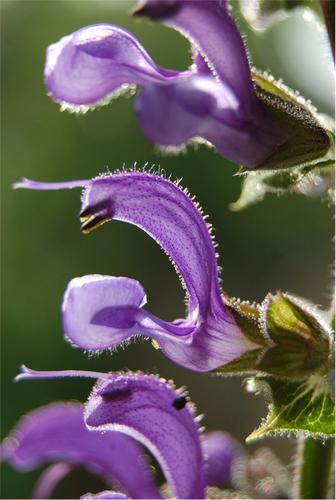Our official English website, www.x-mol.net, welcomes your
feedback! (Note: you will need to create a separate account there.)
Biological Flora of the British Isles: Salvia pratensis
Journal of Ecology ( IF 5.3 ) Pub Date : 2021-10-30 , DOI: 10.1111/1365-2745.13805 Joseph Moughan 1 , Kevin J. McGinn 1 , Laura Jones 1 , Tim C. G Rich 2 , Elliot Waters 1 , Natasha de Vere 1, 3, 4
中文翻译:

不列颠群岛的生物区系:Salvia pratensis
更新日期:2021-12-10
Journal of Ecology ( IF 5.3 ) Pub Date : 2021-10-30 , DOI: 10.1111/1365-2745.13805 Joseph Moughan 1 , Kevin J. McGinn 1 , Laura Jones 1 , Tim C. G Rich 2 , Elliot Waters 1 , Natasha de Vere 1, 3, 4
Affiliation

|
- This account presents information on all aspects of the biology of Salvia pratensis L. (Meadow Clary) that are relevant to understanding its ecological characteristics and behaviour. The main topics are presented within the standard framework of the Biological Flora of the British Isles: distribution, habitat, communities, responses to biotic factors, responses to environment, structure and physiology, phenology, floral and seed characters, herbivores and disease, history and conservation.
- Salvia pratensis is an erect, rosette-forming, perennial herb with a broad native distribution covering much of Europe—from the British Isles, Spain and Morocco in the west, across Europe into Asia, as far east as the Urals. In the British Isles, the species is nationally scarce, confined to a few south- to west-facing sites with calcareous soils in Southern England and one site in Wales. It is predominately found in unimproved pasture, hay meadows and grassy verges, but can occur on the fringes of scrub or woodland. Although the species is abundant in central Europe, changes to land management since the mid-20th century have resulted in fragmented and threatened populations in several European countries. It is cultivated as an ornamental, as is S. × sylvestris, the hybrid with S. nemorosa.
- Populations are typically gynodioecious, having both female (male-sterile) and hermaphrodite individuals at variable proportions. The species has a mixed mating system and is self-compatible via insect pollination, but predominantly outcrosses. Honeybees and bumblebees are abundant pollinators, but a diverse range of bee species and other insect species visit S. pratensis flowers. Inbreeding depression has been documented, presenting a conservation concern for small, fragmented populations.
- The species is the focus of conservation efforts and has been reintroduced to sites where it had become locally extinct in Britain. To sustain favourable habitat, site management should maintain low soil nutrient levels, and prevent scrub encroachment and the dominance of coarse grasses. The removal of sward by hay cutting or grazing after plants have flowered and set seed is advised, in addition to maintaining a degree of disturbance to provide bare patches of soil for seedling recruitment.
中文翻译:

不列颠群岛的生物区系:Salvia pratensis
- 该帐户介绍了与了解其生态特征和行为相关的Salvia pratensis L. (Meadow Clary)生物学的所有方面的信息。主要主题在不列颠群岛生物植物群的标准框架内提出:分布、栖息地、群落、对生物因素的反应、对环境的反应、结构和生理学、物候学、花卉和种子特征、食草动物和疾病、历史和保护。
- Salvia pratensis是一种直立的、形成莲座丛的多年生草本植物,原生分布广泛,覆盖了欧洲的大部分地区——从西部的不列颠群岛、西班牙和摩洛哥,穿过欧洲进入亚洲,最东至乌拉尔山脉。在不列颠群岛,该物种在全国范围内稀少,仅限于英格兰南部几个朝南到西的具有石灰质土壤的地点和威尔士的一个地点。它主要存在于未改良的牧场、干草草地和草地边缘,但也可能出现在灌木丛或林地的边缘。尽管该物种在中欧丰富,但自 20 世纪中叶以来土地管理的变化导致几个欧洲国家的种群支离破碎并受到威胁。它是作为观赏植物栽培的,S 也是。×樟脑,与S. nemorosa的杂交种。
- 种群通常是雌雄同株的,雌性(雄性不育)和雌雄同体的个体比例各不相同。该物种具有混合交配系统,通过昆虫授粉自交,但主要是异交。蜜蜂和大黄蜂是丰富的传粉媒介,但种类繁多的蜜蜂和其他昆虫物种访问S. pratensis花。近交衰退已被记录在案,这对小而分散的种群提出了保护问题。
- 该物种是保护工作的重点,并已被重新引入它在英国当地已灭绝的地方。为了维持有利的栖息地,场地管理应保持低土壤养分水平,并防止灌木丛侵占和粗草的优势。建议在植物开花结籽后通过割草或放牧去除草皮,此外还应保持一定程度的干扰以提供裸露的土壤供幼苗补充。











































 京公网安备 11010802027423号
京公网安备 11010802027423号